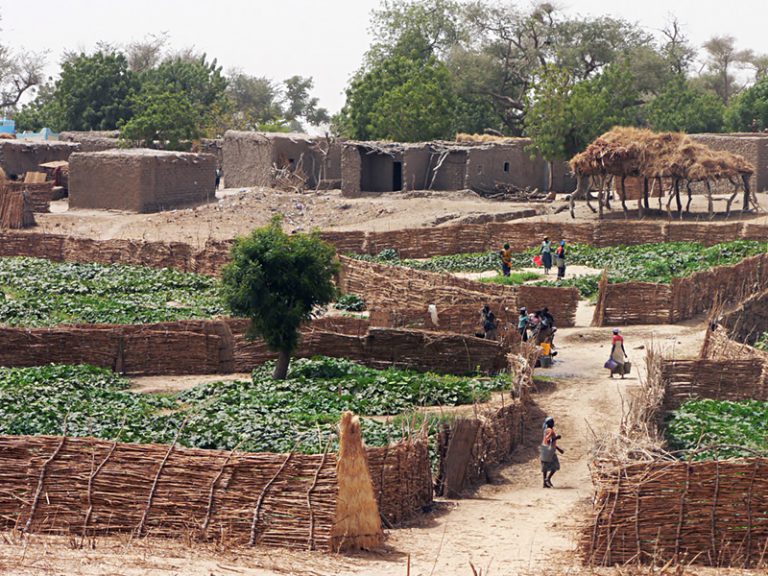Multiple essential functions
Soil carbon: multiple functions benefiting societies and the environment
Soil organic matter (SOM)—and thus organic carbon which accounts for over 50% of its mass—has a key role in the overall behaviour of soils and the agroecosystems they support: soil physical qualities, stimulation of soil biological activity, water and nutrient storage and availability for plants and pollutant regulation. The soil organic carbon content is generally considered to be the prime soil quality indicator, with respect to its agricultural and environmental functions.
The organic carbon content is naturally low in dryland soils—less than 1% of the soil mass—whereas in temperate regions it is 1–2% in cultivated soils and 4–5% in grassland and forest soils. Loss of organic carbon or SOM inevitably results in soil quality degradation and alteration of the soil’s associated functions, creating a vicious circle whereby soil degradation prompts a reduction in agricultural productivity and an increase in food insecurity, malnutrition and famine, etc. Conversely, increasing the SOM directly enhances soil quality and fertility, thus contributing to agricultural resilience and sustainability and, in turn, food security of societies and carbon sequestration.
Global carbon cycle and terrestrial ecosystems
Carbon fluxes between the atmosphere and biosphere are ongoing. Terrestrial ecosystems sequester atmospheric CO2, i.e. around 1–3 Gt* of carbon per year:
• By photosynthesis, the vegetation sequesters around 120 Gt of atmospheric carbon a year in the form of CO2.
• Plants release half of what they have sequestered into the atmosphere via respiration (CO2 emission) while most of the other half is released via ‘soil respiration’ (respiration from roots and from microorganism and soil fauna activity).
Part of the atmospheric carbon sequestered by plants is stored in biomass and soil in the form of organic matter that is gradually transformed into ‘humus’ and stabilized—this is called ‘sequestration’. Through this process, terrestrial ecosystems become sinks that hamper increased CO2 accumulation in the atmosphere. It is already known, however, that global warming will disturb the carbon cycle, especially soil microorganism respiration. The authors of some studies consider that an increase of a few tenths of degrees in temperature could eliminate current carbon sink effects of the biosphere.
Inorganic carbon (carbonates) also occurs in soils, and its distribution and quantity impacts the fertility, erodibility and water retention capacity of soils. In dryland regions, this form of carbon accounts for as much as 68% of the global terrestrial carbon stock. Little is currently known about the impact of the soil management method, e.g. cropping or irrigation, on inorganic carbon reserves and their short-term evolution.
*1 gigatonne (Gt) equals 1 billion tonnes.
Combating desertification, carbon storage and mitigating global warming
In the terrestrial carbon cycle, soil organic carbon is the largest pool of carbon interacting with the atmosphere. The vegetation and atmosphere store much less carbon than soils. There are intense fluxes between soil organic carbon and the atmosphere—soils release CO2, i.e. the main greenhouse gas, via root and microorganism respiration, and trap organic carbon, via photosynthesis and transformation of plant residue into humus. Initiatives aimed at promoting soil carbon storage therefore contribute to mitigating climate change by reducing atmospheric CO2 accumulation, while contributing to sustainable agricultural management. However, land use changes (e.g. deforestation) and some unsuitable agricultural practices (e.g. burning) can lead to a net release of soil carbon into the atmosphere.
Agricultural and forestry systems that reduce atmospheric carbon concentrations by trapping this carbon in biomass and SOM are ‘carbon sinks’, and the process is also called ‘carbon sequestration’. Techniques for combating desertification thus contribute to soil carbon sequestration. These techniques may be mechanical, such as water and wind erosion control measures, which boost organic carbon inputs in soils by enhancing crop production. They may also be cultivation (SOM management through organic inputs, e.g. compost, manure, straw) or biological (fallowing, deferred grazing, quickset hedges, etc.) practices. The zai technique, for instance, enhances organic matter and water management, thus increasing soil carbon levels on a plot scale.
Other techniques are currently being discussed by scientists and civil society stakeholders:
- ‘Biochar’ production and burying were promoted as an innovative solution for rapid sustainable storage of organic carbon in soils. Biochar is produced by pyrolysis of plant residue or livestock manure and ploughed into soils, thus enhancing their agricultural properties. Study findings differ, however, concerning the benefits and relevance of biochar in dryland regions.
- Ramial chipped wood (RCW) input is an alternative management strategy implemented to increase soil carbon contents by burying chipped small diameter branches so as to mimic forest ecosystems. Few studies have confirmed that this increases soil organic reserves or that this method is relevant in dryland regions. The use of RCW is hampered by the irregular availability of this resource and the manpower required for chipping branches.
- Agroforestry systems that combine trees and annual crops can increase soil carbon stocks in dryland regions. Shade provided by trees also reduces the soil temperature and crop evapotranspiration. However, some trials conducted on densely sown plots have revealed underground competition between crops and trees for water, thus eliminating these benefits.
Computer simulation tools currently enable decision-makers and development project managers to account for the ‘carbon’ constituent in their assessments. These easy-to-use tools enable operators to draw up a ‘carbon balance’ for the agricultural and forestry sectors. They can show that agricultural and forestry activities carried out to ensure food security, control land degradation and effectively manage catchments, can also control climate change.
Soils—the top carbon pool
• Atmospheric carbon: around 830 Gt.
• Carbon stored at the global level in plants: under 600 Gt.
• Organic carbon stored in world soils: 2000–2500 Gt, including 27–36% in dryland areas according to estimates.
• Inorganic carbon stored in world soils: 950 Gt, 97% of which is in dry areas.
Carbon at the crossroads of international environmental conventions
Despite the fact that soils are essential for carbon storage, political decisions with regard to mitigating climate change have long been focused solely on industrial, transportation and energy sectors. The impact of forestry and agricultural activities on carbon sequestration has been overlooked, with agriculture and soil carbon being poorly treated in international negotiations. It was not until the 2008 and 2009 food price crises and food riots in Africa that international debates began to be focused on the soil topic. Soil carbon is now a global environmental issue, especially in the framework of the three multilateral environmental agreements (MEAs):
- United Nations Framework Convention on Climate Change (UNFCCC)
- Convention on Biological Diversity (CBD)
- United Nations Convention to Combat Desertification (UNCCD)
The objectives of these conventions differ but they are interrelated, especially with respect to dryland terrestrial ecosystems: desertification, climate change and biodiversity loss interact.
Few tangible policies have been drawn up concerning dryland regions and carbon despite the fact that the UNCCD provides a foundation for synergy between the three MEAs. Agricultural, pastoral and forestry activities especially need to be taken into greater account.
This is reflected in the current ‘carbon market’ system. Although these markets set prices on sequestrated carbon quantities, clearly the ‘carbon volumes’ of agricultural and forestry sectors are low as compared to those of other sectors (energy, industry, residue and waste treatment, etc.). Moreover, these markets—whether set up within the framework of the Kyoto Protocol or voluntarily—do not fully recognize all activities that are conducive to carbon sequestration in agricultural soils.
Carbon markets have so far been focused on checking amounts of carbon sequestered, whereas it would be much easier—and verifiable—to directly promote recognized ‘carbon sequestering’ practices. Such a market could provide much more efficient operational leverage for modifying agricultural practices and setting up systems to protect soils in dryland regions.


